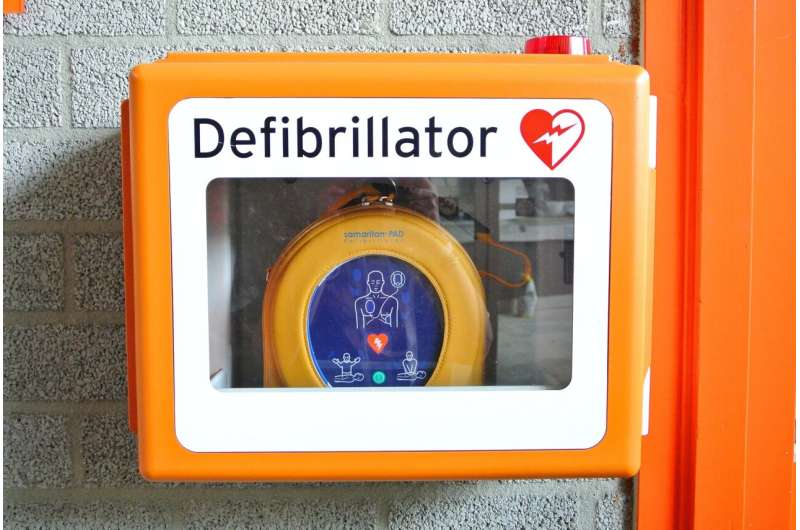This article has been reviewed according to Science X's editorial process and policies. Editors have highlighted the following attributes while ensuring the content's credibility:
fact-checked
trusted source
proofread
Study reveals cardiac arrest figures in England: Just 1 in 12 people survive and leave hospital

A national research database has revealed stark figures for cardiac arrests in England for 2022. Survival rates remain low, with around 8% patients surviving to 30 days after a cardiac arrest.
The ambulance service performed resuscitation in nearly 35,000 patients in England following an out-of-hospital cardiac arrest. Two-thirds of cardiac arrests happened in men, and about 80% happened in the patient's usual residence.
A quarter of patients had their hearts restarted by the time they reached the hospital. Fewer than 1 in 12 patients survived to 30 days. This is a slight decrease from 2021.
Members of the public performed cardiopulmonary resuscitation (CPR) in more than 70% of cases but used a public-access defibrillator in fewer than 10% of cases. Both figures represent an increase from 2021.
These findings are published by the Out-of-Hospital Cardiac Arrest Outcomes (OHCAO) Registry, based at the University of Warwick Clinical Trials Unit—using data submitted by all English regional ambulance services. Its aim is to collect and summarize high-quality data to support U.K. initiatives to improve outcomes from out of hospital cardiac arrest.
Dr. Christopher Smith, Clinical Lecturer at Warwick Medical School and co-chief investigator of the OHCAO registry, said, "The figures from the OHCAO registry show us that survival from out-of-hospital cardiac arrest remains low, with around 1 in 12 people surviving and leaving hospital.
"Cardiac arrest is the most serious and time-critical medical emergency, but there is a lot that can be done to improve patient outcomes. In particular, there is a need to better co-ordinate and implement community-based interventions such as bystander CPR and the use of public-access defibrillators. Such initiatives require high-quality data to identify the scale of the problem and areas where researchers and clinicians can target interventions to have the biggest impact. The OHCAO registry provides and shares this data with the aim of saving more lives in the future."
James Cant, Chief Executive of Resuscitation Council UK, added, "Improving patient outcomes from OHCAO is a key priority for Resuscitation Council UK. We want to save more lives and reduce the devastating consequence of cardiac arrest for patients and their families. This report sheds crucial light on survival, CPR and defibrillator trends, allowing us to apply a data-driven approach in working to save more lives.
"We must now focus on addressing the disparities revealed in the data, boosting CPR awareness, and advocating for wider public-access defibrillator utilization."
Judy O'Sullivan, Director of Health Innovation Programs at the British Heart Foundation, said, "Every second is vital when someone has a cardiac arrest. Quick CPR and defibrillation can be the difference between life and death. These figures lay bare the worryingly low survival rates following an out-of-hospital cardiac arrest, and show that too many opportunities to help save a life are being missed. We need to change this.
"It's important to have the confidence to do CPR and use a defibrillator. Our free, interactive RevivR training tool can teach you the lifesaving skill of CPR and how to use a defibrillator in just 15 minutes, and could ultimately help save the life of a loved one."
The key facts and figures:
- 34,407 people were treated for out-of-hospital cardiac arrest
- Mean age 65.4 years
- Incidence 62.5 per 100,000 people (87.2 for men, 40.4 for women)
Patient outcomes:
- 25.8% patients reached hospital with a "return of spontaneous circulation" (their heart was beating again)
- 7.8% patients were still alive at 30 days
Location of cardiac arrest:
- 80.0% of OHCA occur in place of residence
- 12.7% in public place
- 7.3% all other locations
Actions by bystanders / members of the public:
- Bystander CPR rate was 70% (79.6% when the cardiac arrest was witnessed by a member of the public)
- Bystander public-access defibrillator use was 8.5% (10.6% when the cardiac arrest was witnessed by a member of the public)
More information: Out-of-Hospital Cardiac Arrest Overview: English Ambulance Services 2022



















